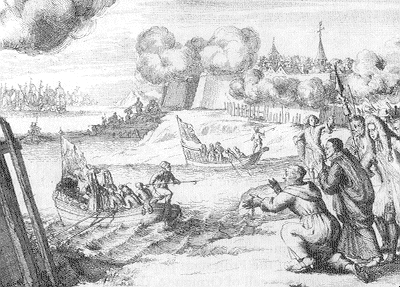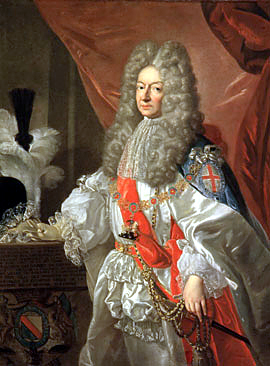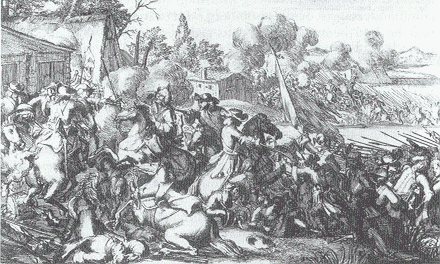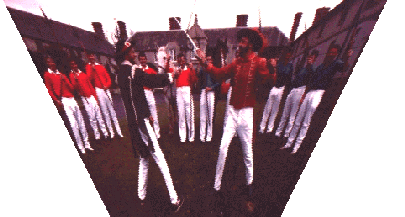The Battle of the Boyne:From the point of view of Europe and Louis XIV the war in Ireland was part of that between Louis and his enemies in the league of Augsburg. The alliance including: Catholic Emperor Leopold and Pope Alexander VIII- who objected to the French domination in Europe and the treatment by Louis of the church in France. Although William was a sincere, tolerant king free from bigotry, liberal and enlightened. This was one instance when the king was wiser and more considerate than the Parliament which now controlled him. The Parliament, always concerned with expenditures of revenues, allowed concerns for the cost of the war to lead to Irish and Catholic intolerance. The Pope: Alexander VIII -was William's ally. William was Calvinist but was tolerant- there were Catholic officers in his army. The war was not for the Irish nor for the Protestant cause but against the Bourbon Absolutists and for the freedom of Europe.
James II went to Ireland because Tryconnell was loyal and Ireland might provide a jumping off point to Scotland and England, but, he was also strongly motivated by Louis XIV-to divert William III from his continental campaign and free up French Armies. When James landed in 1689 he set up a Parliament in Dublin to confiscate Protestant lands. Tryconnell had already purged Protestants from the army and all government positions. When James was expelled from England Tryconnel began to increase the size of the army. Once James had been removed from office it was feared that the Papists planned to massacre Protestants. The poorly paid military levies had already begun to plunder the country. As a result there was a mass exodus of Protestants to England. Other Protestants such as those at Londonderry prepared for their self defense. Just as intolerance in France following the revocation of the Edict of Nantes lead to the loss of Protestant capitol, skills, and resources, so too in Ireland the Protestant flight saw the departure of Ireland's many successful businessmen along with their large stores of hard currency. Jean-Antoine de Mesmes, Comte d' Avaux was sent by Louis XIV to represent him as ambassador to Jame's court. James had retired to St Germain where he was provided for by Louis. Despite his fatalism James agreed to lead the campaign to Ireland. When James arrived the army was disorganized. In addition to having to have to deal with the ongoing civil war it had to deal with the legacy of its prior history as a dispersed force and with the demoralizing effects of the replacement of all Protestant officers with Catholics carried out by Tryconnell. The disruption caused by the arrival of James and the call to arms left the country virtually without an economy. Protestant business had fled, trade with England was halted, and many left the fields to grow wild in order to join the armies. No provision had been made for the supply of a great army, and those who served as mercenary soldiers soon took to the countryside and to robbery and pillaging to obtain their livelihood. The shortage of hard currency lead the army to melt down brass guns and to resort to copper currency. Despite his fancy welcome to Dublin James and his army appeared to the Irish not as a force of liberation but as a cancerous scourge upon the land. William of Orange landed and immediately put a stop to the plundering which members of his army had engaged in-he hanged the plunderers. He brought many guns, men, and supplies including a prototype of the first machine gun a wheel-engine that could fire 150 muskets at once and then when turned fire the same number again. In stark contrast the Irish forces possessed no artillery nor siege skills.
Prior to the Battle of the Boyne the Irish Army had been forced to give up the
siege of Derry but had fared better in the winter months than the English army.
Jame's evil and incompetent advisor Melfort had resigned and things were looking
up for the army by December. If Louis followed through with French assistance
there was a chance of defeating the English. James had also succeeded in
alienating the French. The French general Rosen was sent back to France and
James insisted that he be replaced by Antonin Nompar de Caumont Comte de Lauzun
(shown here) (what a stark contrast to the warlord celtic chieftain Neill
O'Neill Look at
Neill no wonder the French never saw eye to Prelude to the
Boyne... The Lay of the
land.... It was a bright and cloudless
morning.... James II: 25,000 men. Many raw levies- Ill armed./Short of Guns/.The Irish wore the white cockade-in honor of their French support. James also had some English, Germans and Dutch in his army. James did not fight himself, but, rather, left the leadership of his army entirely to his general : Sarsfield. Irish and French fought together. The Jacobites had taken up position on the south bank of the River Boyne to the West of Dundalk. Wiliam's assets included: 36,000 men/a composite army made up of-Danes, English, Dutch and French Huguenots,Germans,Scots,Irish,Swiss,Italians,Norwegians and poles. William's elite unit was the Dutch Blue Guards- They were Catholic!
William deployed his forces on the northern Bank of the Boyne. A cannonade by both sides was launched and lasted for a day and a night before the battle. The night before William annoyed his generals by developing his own strategy. Schomberg was not pleased and returned to his tent muttering that he had been more used to give such orders than to receive them. William was to order a direct frontal assault across the Boyne, while his right wing, lead by one of Schomberg's sons (Meinhard) was to march up river to the Slane to turn the enemy's left flank. James commanded Sarsfield to hold a body of horse in the rear for his escape. James did not listen to warnings that William would make flanking movement to cross the Boyne at Slane. He also did not accept offers of assistance from Louis XIV of sea and land power. Sunrise: Schomberg''s men were seen along the height going to make that flanking move. James orders his whole wing, part of center, six remaining guns to meet flanking division. Too late!- the enemy crossed the river Other fords were hotly contested. Low water-created other crossing points. One battalion of infantry held the ford at Oldbridge-it was attempted by William's men. For half a mile the Boyne was filled with thousands of armed men trying to get to the opposite bank. Schomberg took Oldbridge. Seven battalions went down to the help of the infantry. Two battalions of Irish Guards scattered them but cavalry went across another ford and attacked the infantry. Bravely responding to the threat of the French cavalry Schomberg left the bank from which he was watching and without armor rode into the battle. He cried to the French Hugenot troups around Him: Come on,gentlemen:there are your persecutors!" Schomberg was killed-
But William stepped in to take his place. "one of the most remarkable peculiarities of his man, ordinarily so saturnine and reserved, was that danger acted on him like wine, opened his heart, loosened his tongue, and took away all appearance of constraint from his manner. On this memorable day he was seen wherever the peril was greatest. One ball struck the cap of his pistol: another carried off the heel of his jackboot; but his lieutenants in vain implored him to retire to some station from which he could give his orders without expo sing a life so valuable to Europe. His troops, animated by his example, gained ground fast.-Lord Macauley, History of England. William at the head of a contingent from Enniskillen said: Cavalry was brought up to help battalions to retire-but then charged again and again 10 times. Then, holding back William's men they rejoined James. (source: Duke of Berwick) The battle raged all day. At 5 p.m. James left the field and at the end of the day the Irish were forced to retire-but in good order for the most part. It was in reality a drawn battle. Celebrated by a Te Deum in Catholic Vienna the battle began the end of Louis XIV in Europe and the downfall of the Old English Loyalist aristocracy (Catholic Norman with Gaelic survivors and later Elizabethan additions). In this way the outcome of the battle in political terms was an exchange of aristocracies- the Protestant and Anglican ascendancy replaced the Old Irish and Catholic aristocracy. Gaelic culture was transferred from the highest ranks to the peasantry to be guarded there till its rediscovery in the 19th century. Importantly advances made in England in the development of a constitutional monarchy were protected from those who would wish to revive absolutism. This is of worldwide significance. For an important battle casualties were slight- fifteen hundred Jacobites and
five Hundred Williamites. James reached Dublin at 10:00 he had taken 200 men. Lady Tryconnell met him at Castle-gate. Upstairs she asked him what he would have for supper -He gave her an account of what a breakfast he had got which made him have little stomach for his supper . It is said that when he declared that the Irish army had run away she answered, "but Your Majesty won the race" The armies of James both Irish and French marched back in good order to Dublin. They rested and prepared to head out again. James railed at them and stated that the Irish had basely fled the field and he would never lead an Irish army again and advised the armies to submit to the Prince of Orange. He went to Waterford, took a ship to Kinsale and then to France. And with James left the threat of Absolutism to Ireland. James requested that the Irish surrender as they no longer had a chance. They did not do this and carried out a long war against England which they lost. As a result of this attack upon England ( and against the best wishes of William) Parliament implemented a tough set of penal laws against Catholics. This outcome was also a consequence of the role of the foreign Jesuit advisors and French Catholic influence which had instigated and supported James. It is surprising that to this day many Irish can not understand why it was that when Irish armies brought in foreign assistance (especially from Catholic entities to fight against England), that England punished Irish Catholics. History shows that the settlement at the treaty of Limerick ( which allowed the Irish army to go unharmed to France) was a rather mild one. Most soldiers who lost wars in the period did not usually survive the peace. Undoubtedly had James triumphed Ireland would have seen unparalleled
religious intolerance and, its resources would have been taken to feed the
armies of France. Arguments of support for this Stuart tyranny should be closely re-examined as few merits for it are found in the historical record. Following the end of the war William called a parliament to safeguard
Catholics
Sources:MacManus,Seumas, The Story of the Irish Race.,Devin-Adair,New York,1975 (pp.436-453) Faolain,Turlough,Blood on the Harp.,Whitston,Troy,Ny. 1983. 17-176 Some points above come from: Cathcart,Rex,Ireland and King Billy Usage and Abusage. History mag ?pp41-45 J.G Simms,Jacobite Ireland,Routeledge and Kegan Paul,1949 Remembering 1690 Studies in Irish quarterly Review,1974 Hill,Jacqueline R.,National Festivals the State and Protestant Ascendancy, In Ireland 1790-1829, \Irish Historical Studies 1984. Hereward Senior,Orangism in Ireland and Britain 1795-1836, Routledge and Kegan Paul 1966 M.W Dewar, J. Brown and S.E. Long, Orangeism, Grand Lodge of Ireland ,1967 Curtis,Edmund, A History of Ireland., Methuen and Co,London,1968. To return to the main Battle Page click here
Send Me your Contribution-add to these pages!-Give us your input!Oranje boven!!!!!
|

 eye with the Irish!) a man with
little or no military skills or experience. This act in turn alienated D'Avaux
who was a very able advisor. The French were beginning to feel that support for
James would be putting valuable men and money into incompetent hands. By the
first half of 1690 resentment for the French in Ireland was high and the king's
council was divided by continual argument.
eye with the Irish!) a man with
little or no military skills or experience. This act in turn alienated D'Avaux
who was a very able advisor. The French were beginning to feel that support for
James would be putting valuable men and money into incompetent hands. By the
first half of 1690 resentment for the French in Ireland was high and the king's
council was divided by continual argument.

 The "Black
Order" of the Orange Order stage a ritual fight between James and William-James
usually looses!
The "Black
Order" of the Orange Order stage a ritual fight between James and William-James
usually looses!